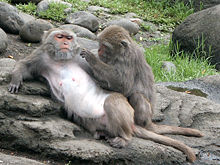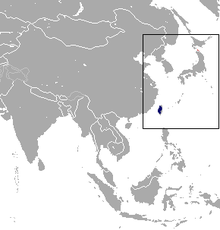Macaca cyclopis
| Formosan rock macaque | |
|---|---|
 |
|
| Scientific classification | |
| Kingdom: | Animalia |
| Phylum: | Chordata |
| Class: | Mammalia |
| Order: | Primates |
| Family: | Cercopithecidae |
| Genus: | Macaca |
| Species: | M. cyclopis |
| Binomial name | |
|
Macaca cyclopis (Swinhoe, 1862) |
|
 |
|
| Formosan rock macaque range (blue — native, red — introduced) |
|
The Formosan rock macaque (Macaca cyclopis), Formosan rock monkey, or Taiwanese macaque, is a macaque endemic to the island of Taiwan and has been introduced to Japan. Besides humans, Formosan Rock Macaques are the only native primates living in Taiwan.
Rock macaques measure 50–60 cm and weigh 5–12 kg, generally females are smaller. Their tails are moderately long and measure 26–45 cm. This macaque is brown or gray in color. The monkey has specialized pouch-like cheeks, allowing it to temporarily hoard its food. The gathered morsels are eaten sometime later, in safe surroundings.
Among the 22 species of the genus Macaca that are found in southern and eastern Asia as well as northwestern Africa, the Formosan macaque is endemic to the island of Taiwan (area: 36,000 km2).
Formosan rock macaques lives in mixed coniferous-hardwood temperate forest, as well as bamboo and grassland at 100-3600m (328-11,812 ft). The social structure of macaques is generally characterized as often occurring as a large stable multimale-multifemale troop. Formosan macaque is considered to be female-bonded which is similar to other species in the genus Macaca. Based on the study of Hsu and Lin, the average overall sex ratio was approximately 1:1, and the average adult sex ratio was close to 0.53. Solitary adult males were accounted for 5% of the entire population, and they were seen interacting with social troops especially during mating season.
Rock macaques are diurnal, arboreal, and terrestrial. More often they stay in trees and less so on the ground. They rest in forest and forage in grassland. Their diet consists of fruits, tender leaves, buds, grass stems, insects, snails, and bird eggs.
...
Wikipedia

